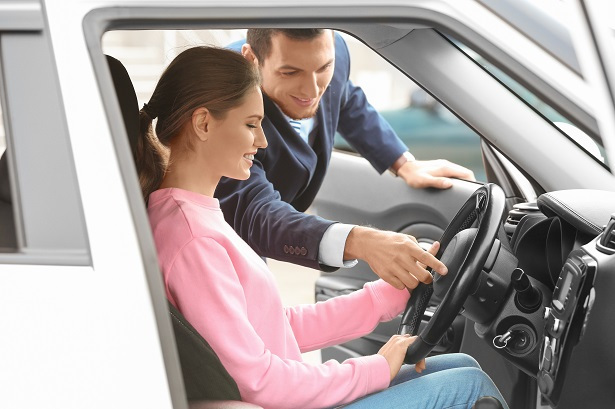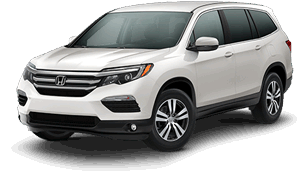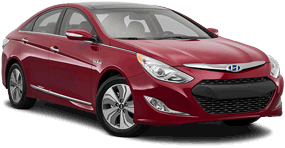Buying a car can be an intimidating process for anyone, but for the first-time car buyer, it can be downright overwhelming. Before rushing into a dealership to purchase the vehicle, there are a few simple steps unseasoned car shoppers can take to prepare themselves. Identifying your priorities for the vehicle, budgeting for this large purchase, and being savvy about financing and negotiating all add up to a better shopping experience and a better bottom line price. The following five tips will fool the car salesperson into believing this isn't your first rodeo.
1. Prioritize Vehicle Needs

It's common for first-time car buyers to fall in love with a vehicle and lose perspective about their day-to-day needs. For a busy college student or recent grad, an affordable used car with good reliability ratings is a responsible choice. For city dwellers, a compact sedan or SUV will make navigating traffic and tight parking spots a no brainer, and for the adventurous soul, a rugged SUV or truck will allow them to pursue the unbeaten path.
A simple way to find a car that hits most of the day-to-day requirements is to create a list of features you need and look for vehicles that fit the criteria. Reading buying guides to compare vehicles within segments is helpful to narrow down your search. Once you've identified a list of cars that hit most, if not all, of your checkboxes, in-depth car reviews will give you a better idea of the features, styling, and performance or each one.
Some common features the majority of car shopper look for include: the vehicle's fuel efficiency ratings, reliability scores, technology, driving dynamics, and cargo space. Not sure where to start? See our list of the best vehicles for first-time car buyers.
2. Budget

For most people, a car purchase is typically the second largest expense after buying a home. For the average first-time car shopper, it is a balancing act between getting a car that fits his or her needs and staying within a comfortable budget. Determining how much you can afford to spend on a car can be confusing. Although each car buyer's situation is different, a good rule of thumb is to avoid spending more than 10-20% of your annual income on a vehicle. On top of the initial cost of the car, it's important for new car owners to remember the additional expenses like maintenance, fuel, and car insurance.
For a first car purchase, consider going with a used car as opposed to new. On top of a higher initial purchase price, new cars experience significant depreciation, losing up to 11% as soon as they are driven off the dealership lot. The average new car depreciation is 22% in the first year so buying a car that is just one year old will allow you to bypass the bulk of this initial depreciation.
If you plan to finance your vehicle, you should budget for a down payment of at least 10 percent for a used car and 20 percent for a new car. Although it can seem like a large amount to put down at one time, you're better off saving up for a substantial downpayment to keep your interest rates low.
3. Consider Financing Options

You may be surprised to see us address financing before visiting the seller or dealership for a test drive. Your plan for financing the vehicle should be considered early in the process to have the best chance at timely loan approval and a good interest rate. Many first-time car buyers don't have sufficient credit built up which can negatively impact their credit scores. A low credit score puts a car shopper at risk of getting rejected for a car loan or having to pay an outrageously high interest rate which can result in overpaying by thousands of dollars over the course of the loan.
For a newbie car buyer without much credit history, applying for car loan preapproval and finding a cosigner can significantly improve the chance of getting approved with the lowest possible interest rate. Auto loan preapproval means applying for car loans prior to going to buy your vehicle and getting offers for a loan amount and interest rates. You can either accept the terms or go with other options.
Enlisting a cosigner such as a parent or other relative with good credit is often the best financing decision for young car buyers. Just remember that if you miss a car payment, your lender will go directly after your cosigner to collect the funds.
Get Pre-Approved for a Car Loan Today
4. Check Out the Vehicle

After you've narrowed down your list of cars to a few options that fit your needs and your budget, it's time for the fun part. This includes testing out your list of vehicles to see how they drive and evaluating features like cargo space and technology to see if they will fit your everyday use case. Some car salespeople will try to rush you through the test drive process in order to get you inside to start the paperwork. Take your time with this step so you have no regrets later and use the following checklist for inspecting and test driving a new or used vehicle.
Test Drive Checklist
- Walk around the entire vehicle. Are you happy with the way the car looks? How are panel gaps in the door and near the hood and trunk? Usually the bigger the gaps and the looser the tolerances, the more poorly a car has been designed/built.
- Look at the paint during the day since at night it's hard to distinguish color variances.
- Take the time to properly adjust the driver’s seat and position all mirrors correctly. Adjust the steering wheel for optimal comfort and driving safety. Check headroom, legroom, and
hip room .Also, be mindful of seating comfort throughout the drive. Are front and rear seats easy to adjust? - How
is visibility, out the front, rear and side windows? Is your seating position good so you can tell where the corners of the car are? Are the blind spots bad? - How are the controls for climate, audio, etc? Make sure these are easy for you to use so they don’t become cumbersome or confusing while driving.
- Start up the engine and put it into gear. Does the car respond well when you press the pedal? Is acceleration smooth? How does the engine sound? Is it comfortable to drive in the city and on the highway? Is the road noise level high at faster speeds?
- Does the car brake well? Is the pedal progressive, or do the brakes grab suddenly?
Also, practice braking hard to see how the car responds. - Does the car turn well and is it easy to maneuver? Are the tires noisy or quiet at higher speeds? How does the suspension take bumps in the road well?
- Check the features on the car and see if they work well. Is the navigation accurate and easy to program? Is the infotainment system intuitive? How hard is it to pair your phone with the vehicle?
- How roomy is the trunk or cargo section? If you have small children, bring along a child seat(s) and try to install it. Is it easy, and is there enough room?
5. Negotiate the Price

After a successful test drive, it'll be time to sit down and talk numbers. Negotiating the price of the vehicle can be one of the most stressful parts of the car buying process for the first time buyer. Make sure you go in prepared by doing research and requesting online car quotes. If you have several dealerships near you, you should request quotes from all to compare.
When you're negotiating the car's price, make sure you avoid falling into the trap of discussing the monthly payments. You should negotiate the car price, finance terms, and your trade-in separately. Allowing the salesperson to roll everything up into a monthly payment leaves some gray area for him or her to raise the price. You should insist on negotiating the lowest possible price on the car first and only after you land on a comfortable number, should you move on to the financing and trade in. Finally, don't let the salesperson pressure you into signing the contract that day. You can visit another dealership or come back another day if you're not happy with the price or aren't ready to buy.


